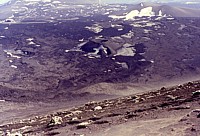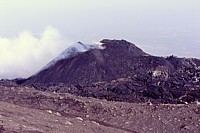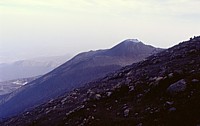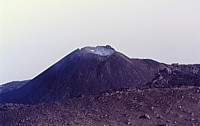A single summit visit in two months, March-April 1998
In
March and April 1998, the summit craters of Etna showed much the
same levels of activity as during February, with the exception
of a single, brief, but very violent episode of lava fountaining
at the Northeast Crater on 27 March. During most of that period
I did not get to see all that much of the volcano, since I had
to deal with things like burglars breaking into my first home
in Catania (there wasn't actually much to steal, during the first
year of marriage my wife and I lived in sheer poverty) and, as
a consequence, we immediately looked for (and found) a new, and
safer, apartment. When a group of scientists from the University
of Utrecht (Netherlands) asked me to accompany them to Etna and
the Aeolian Islands in early April 1998, I agreed, and we had
a fine excursion to all four summit craters of Etna on 6 April.
One of the results of that positive experience is that Boudewijn
t'Hart, the organizer of that trip, has organized field trips
to Etna and the other volcanoes of Sicily every year since then,
and always asked me to serve as a local volcanological guide for
his groups. Some of these trips have left remarkably positive
memories in all of the participants, but the first visit, made
by a very small group on that 6 April 1998, was probably the most
intriguing... you might understand when looking at the photos.
Distant,
tempting Etna, mid-March 1998
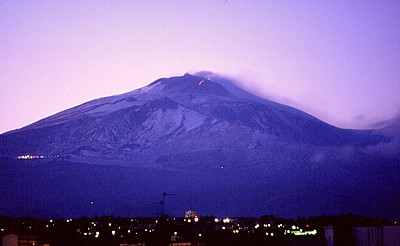
|
| On
clear evenings during the early months of 1998, sights like
this one were common to those looking at Etna from Catania
and nearby areas. This photograph, taken around 20 March
1998, is a view toward Etna from the roof of the Palazzo
delle Scienze in Catania, the building that hosts the Department
of Geological Sciences of the University of Catania. A small
explosion is seen at the summit of the intracrater cone
of the Southeast Crater, while a tiny lava flow has begun
to spill down the south-southwestern flank of the Southeast
Crater cone. Behind the Southeast Crater rises the much
larger central summit cone, with a peculiar nose-shaped
peak in its center, which is all that remains of a large
pyroclastic cone formed in 1964 in the southern portion
of what was then the Central Crater. The Central Crater
was practically eliminated during the 1964 eruption, since
it was filled to overflow by lavas and pyroclastics. Most
of the 1964 cone has been removed by the widening (by collapse)
of the Bocca Nuova, which began to form in 1968.
The horizontal row of lights on Etna's slope near the left
margin of the photograph marks the location of the large
complex of tourist facilities around the Rifugio Sapienza.
Most of the lights are actually streetlamps illuminating
a 500 m-long section of the road that connects the tourist
complex with the towns of Nicolosi and Zafferana. Since
the 2001 eruption, there are much less lights there, since
nearly all of the streetlamps were destroyed by lava flows |
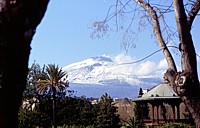 |
Two
exceptionally clear views of Etna from the center of Catania
(the "Villa Bellini", a beautiful public park)
in mid-March 1998, showing much detail of the volcano's
southern flank and the summit craters, with a white gas
plume rising from the Southeast Crater |
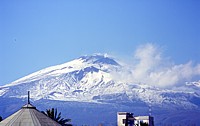 |
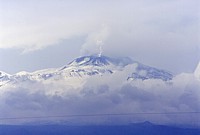 |
Left:
a glimpse through weather clouds of Etna's summit craters
from a train near Acireale, southeast of the volcano. Note
white gas plume rising from intracrater cone of the Southeast
Crater. Photograph taken on 13 March 1998
Right: Etna at sunset, seen from the roof of the Palazzo
delle Scienze in the center of Catania about 20 March 1998 |
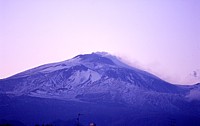 |
Return
to the summit craters (all four of them), 6 April 1998
As
noted above, the 6 April visit was made with a group of professors
and PhD students from the University of Utrecht, Netherlands,
and it was made only about ten days after a powerful paroxysm
from the Northeast Crater - the first significant eruptive event
at that crater since August 1996. This paroxysm lasted less than
two hours during the night of 27-28 March 1998, and in spite of
the huge lava fountains it produced, it produced an amazingly
modest pyroclastic deposit (see a more detailed description in
the archived March-April
1998 Etna News; note that the links to external web sites
on that page are all dead!). To assess the effects of that event,
I visited all four of the summit craters, some of them with the
Dutch scientists. Most of the time, however, was spent at the
Southeast Crater, whose intracrater cone presented some surprising
morphological changes (probably due to a period of intense activity
on 17-28 March, at the same time of the Northeast Crater paroxysm),
and we were able to approach the sites of effusive activity. While
clambering over the chaotic terrain on the lava field filling
the Southeast Crater, one of the Dutchmen stumbled and fell -
normally, on a field of 'a'a lava this would leave one seriously
injured. But that man had done combatant sports for much of his
life, and he knew well how to let himself fall, so he received
just a few very minor scratches. Among the many stories I lived
through on Etna in these years, this is one of those I like best.
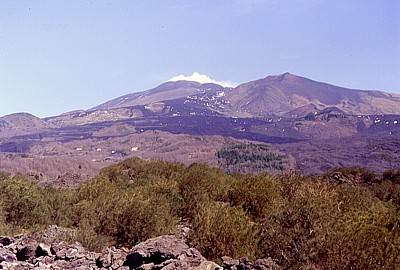
|
| The
upper half of Etna's southern flank is seen in this photograph
taken on 6 April 1998 from a fine lookout a few kilometers
to the north of the town of Nicolosi. The summit craters
are seen in the center of the image, with a white gas plume
being fed largely from the Bocca Nuova, which occupies the
left half of the central summit cone. The small rounded
knob at the right base of the central summit cone is the
Southeast Crater, and the summit of its active intracrater
cone can be seen looming over the crater rim. To the right
of the summit craters, and apparently rising higher in this
perspective, is the Montagnola, a large pyroclastic cone
that was formed during an unusually explosive flank eruption
in 1763. The peak of that cone actually lies at an elevation
of 2645 m, nearly 700 m below Etna's summit. The prehistoric
pyroclastic cone of Monte Vetore lies at the left margin
of the photograph. Dark lavas in the center of the image
are of the 1983 eruption; further upslope these are in part
covered by lavas erupted during an eruption in March-July
1985 |
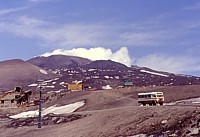 |
Left:
a look from the arrival station of the cable car toward
the summit of Etna, 6 April 1998, with a tourist jeep-bus
in the right foreground. Nearly everything that can be seen
in this image (except for the bus) has changed since then
Right: southwestern flank of the Southeast Crater cone on
6 April 1998, the eastern side of the central summit cone
is at left |
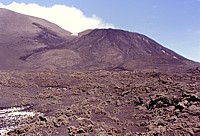 |
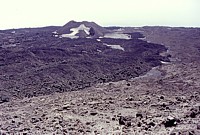 |
While
climbing up to the Southeast Crater on the southwestern
flank of its, cone, the lava flow of early January 1998
is well visible for its dark color, due to its recent age.
This flow arrived near the small pyroclastic cone of 1971
("Observatory cone"), about 500 m south of the
base of the Southeast Crater cone |
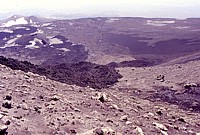 |
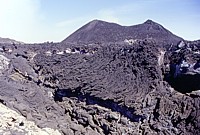 |
Viewed
from the southwestern rim of the Southeast Crater, the intracrater
cone is seen to have changed significantly in shape since
my previous visit on 18 February 1998. The cone appears
much broader and is truncated by a much larger crater than
previously; much new lava (some of it being ropy pahoehoe,
as in left image) has been added on the surrounding crater
floor |
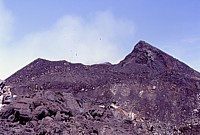 |
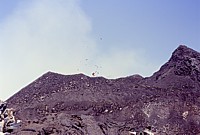 |
Getting
closer to the changed intracrater cone, more detail of its
new morphology become evident. The active vent, invisible
from the base of the cone, lies somewhere in the central
portion of the flat area marking the summit of the cone
(an explosion is visible in left photograph). View in right
image shows the eastern summit crest of the cone |
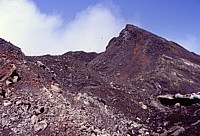 |
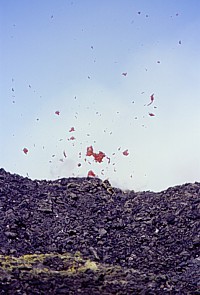 |
I
did get quite close to the active vent of the intracrater
cone of the Southeast Crater on 6 April, but the zoom lens
of my camera helped quite a bit in obtaining these images
of incandescent clots of lava being ejected by small Strombolian
bursts. The largest of those clots in the right image is
well one meter across. The nature of the circular feature
rimmed by yellow sulfur deposits in the left image is unknown |
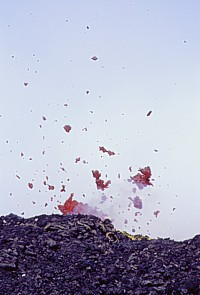 |
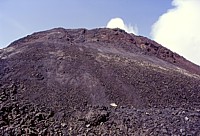 |
Left:
the steep southeastern side of the intracrater cone, showing
evidence of some endogenous growth, which led to the steepening
of the flank
Right: a flat lobe of unusually smooth lava is slowly expanding
over chaotic terrain at the eastern base of the intracrater
cone. The source of this lava lies above the triple lava
sheet in the center right of the image |
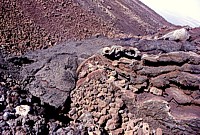 |
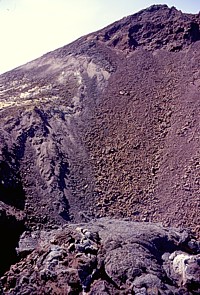 |
Left:
the source of the slow-moving pahoehoe lava seen in the
previous image lies below a peculiar depression in the eastern
flank of the intracrater cone. Such depressions were frequently
observed above newly opened effusive vents at the base of
that cone in 1997-1998. They were probably formed by the
draining of "pockets" of magma, which coincided
with the opening of new effusive vents at the base of the
cone
Right: a closeup view of an active, though crusted-over,
pahoehoe lobe, whose slow expansion causes the surface crust
to crack open, exposing the incandescent interior. Width
of the active lobe is about 0.5 m |
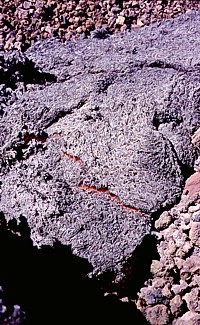 |
 |
Details
of advancing pahoehoe lobes fed from the same source as
the flow shown in previous image. The image at right shows
the extrusion of a fresh lava lobe through a crack in the
crust of a previously emplaced lobe, a mechanism that strikingly
resembles the formation of pillow lava under water |
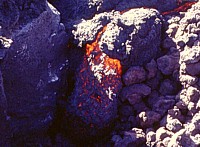 |
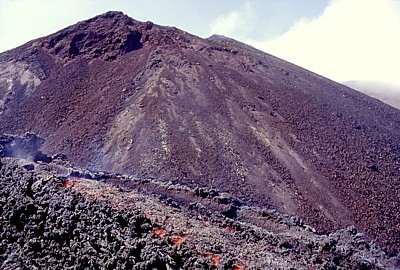
|
Some
20-30 m to the northeast of the source of the small pahoehoe
lava flows shown in the previous photographs, more voluminous
emission of lava occurs from a typically U-shaped effusive
vent that marks the exit of a lava tube. The flow issuing
from that vent is 2-3 m wide at the bottom of this photograph,
and moving at a speed of max. 0.1 m per second. The eastern
flank of the intracrater cone with the collapse depression
above the newly formed effusive vents is seen in the background.
6 April 1998 |
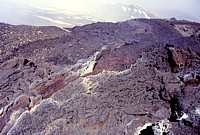 |
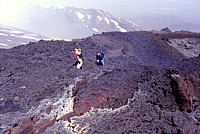
|
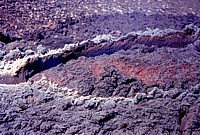 |
Active
effusive vent to the east of the intracrater cone of the
Southeast Crater on 6 April 1998. Left image shows the position
of the vent at the end of a crack that marks the trace of
a lava tube through which lava is transported from underneath
the intracrater cone to the effusive vent. In the center
photograph, Boudewijn t'Hart from Utrecht University (Netherlands)
is posing next to the lava flow emitted from the effusive
vent. More detail of the vent is visible in right photograph |
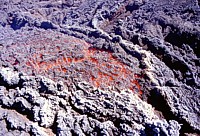 |
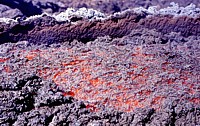
|
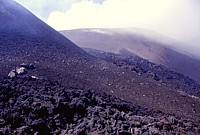 |
Left
and center photographs show further detail of the effusive
vent shown in the previous images. Image at right shows
the northeastern base of the intracrater cone of the Southeast
Crater, where a strip of lava-free terrain has remained.
The broad cone in the background is the Northeast Crater |
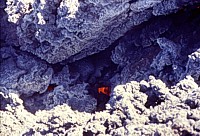 |
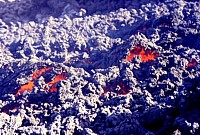
|
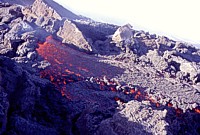 |
Lava
below the surface and at the surface, blocky and smooth
- on 6 April 1998, many types of effusive activity can be
observed on the floor of the Southeast Crater, although
they all have one thing in common: very low effusion rates
(generally 0.1 cubic meter per second or less). A glowing
hole in an inactive but recent lava flow is seen in left
image; note white sublimates (calcium sulfate) on lava surface.
Slowly flowing, largely crusted-over lava is visible in
center image. A rapidly expanding lobe of relatively smooth
lava is oozing from an effusive vent that has opened less
than one hour before (right photograph) |
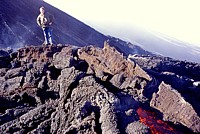 |
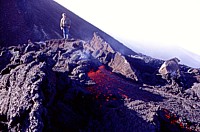
|
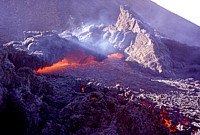 |
The
newly opened effusive vent lies at the eastern end of a
so-called tumulus, a bulged area with a prominent central
crack formed as the roof of a lava tube is broken by expansion
of lava within the tube. This occurs when there is a rapid
increase in the lava supply rate, or the tube is blocked
"downstream" (or is it "downtube"?)
from the position of the tumulus. Person standing on top
of tumulus indicates scale |
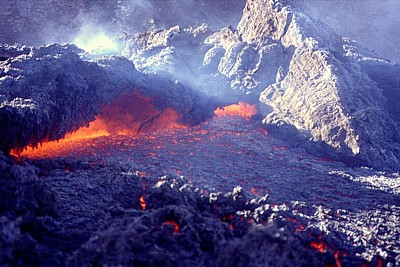
|
A
look into the fiery mouth of the newly formed effusive vent
shown in the previous photographs. One can actually recognize
the cavity from which the lava is issuing - the roof of
an active lava tube |
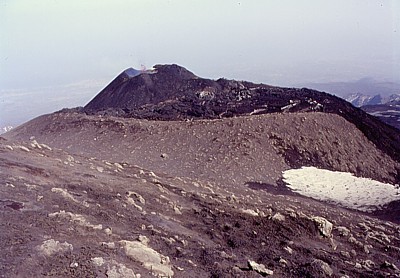
|
Spectacular
panoramic view on the Southeast Crater (which should be
better described as a lava platform with the intracrater
cone sitting on it) on 6 April 1998. A burst of glowing
bombs is occurring from a vent within the large depression
formed at the summit of the intracrater cone during the
vigorous activity about ten days earlier. Note dark recent
lavas that have overflowed onto the external slope of the
Southeast Crater cone at right, contrasting with the lighter-colored
material making up the portions of the crater rim still
not covered by new lavas |
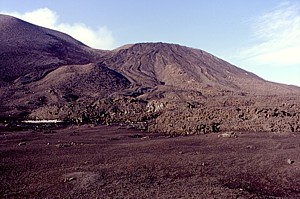 |
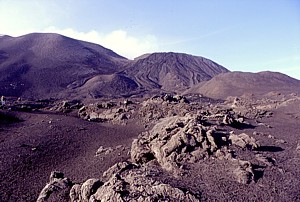
|
The
cone of the Southeast Crater seen from southwest during
the late afternoon of 6 April 1998, with more contrast
generated by the low-standing sun. With this illumination,
the levees of the lava flows draping the southern and
southwestern flanks of the cone are well visible. Furthermore,
the half-buried "Western vent" of the 1971 eruption
can be seen at the left base of the Southeast Crater cone,
encircled by two lava lobes in January 1998. Another cone
of the 1971 eruption, the "Observatory cone",
is visible in the right foreground of the right photograph.
The bulky mass of the central summit cone, of which a
part is visible in both images, especially the right one,
rises mightily above the small, low hill that is the Southeast
Crater cone - that was the situation back in early 1998.
One year later, the same cone stood 50-60 m higher, and
as of 2001 had grown higher than the southeastern rim
of the former Central Crater
|
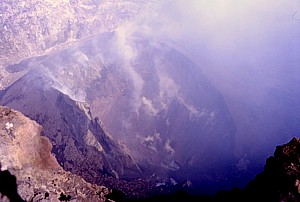 |
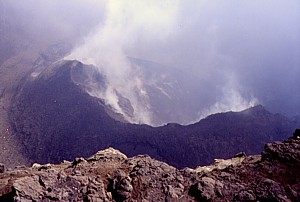
|
On
6 April, deep silence fills the Bocca Nuova again, and the
large northwestern cone on the crater floor is seen to have
undergone more collapse since I last saw it on 10 February
1998. The entire southern half of the cone has gone, and
the floor of the collapse depression lies below the level
of the surrounding crater floor. The view at left is from
the southwest, that in the right image from northwest |
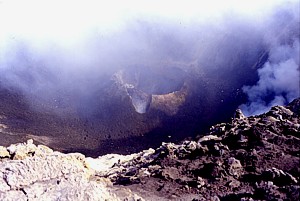 |
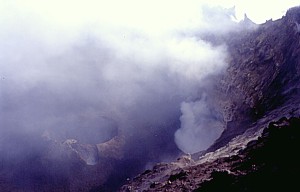
|
Meanwhile,
something is going on in the adjacent Voragine, which is
separated from the Bocca Nuova only by a thin but surprisingly
stable rock septum, the "diaframma" (the craggy
crest of the "diaframma" is visible in the upper
right corner of the right photograph). The strongly degassing
vent at the base of the "diaframma" (right photograph)
was first observed in early November 1997 and has enlarged
significantly since then. During the 6 April 1998 visit,
explosions occurred at that vent, sometimes ejecting bombs
above its rims. The central intracrater conelet, visible
in the center of the photograph at left, and in the left
half of the right image, is still completely silent, but
its morphology has changed, with the appearance of a small
pit on the near (western) crater rim. Note the impact craters
on the crater floor in central-left part of the left image;
these were formed by ballistic bombs ejected during the
lava fountaining episode of 27-28 March 1998 at the Northeast
Crater, only a few hundred meters away |
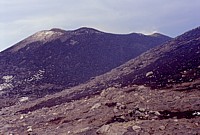 |
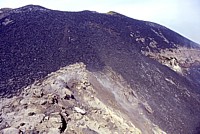
|
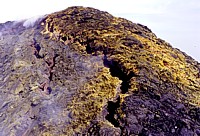 |
The
Northeast Crater, the site of a spectacular episode of vigorous
lava fountaining only ten days before the 6 April 1998 visit,
is seen in these photographs, as our excursion group approached
and climbed the crater.
Left: the Northeast Crater seen from the northwestern rim
of the Bocca Nuova. Its cone is covered with black scoriae
of the lava fountaining episode of 27-28 March, but this
deposit barely extends down to the base of the cone, and
virtually no pyroclastics of that event can be found at
the Bocca Nuova.
Center: a closer view of the southern flank of the Northeast
Crater cone, seen from the western rim of the Voragine (the
light-colored crest in the foreground). While the 27-28
March 1998 pyroclastic deposit is well recognizable for
its black color on the flank of the Northeast Crater cone,
only a few bombs lie on the rim of the Voragine in the foreground,
although the viewing point is only a few hundred meters
away from the active central pit of the crater. People climbing
up the steep slope of the Northeast Crater (visible in the
enlarged version of the photograph) give a scale.
Right: yellow sulfur deposits coating the ten-days-old pyroclastic
deposit on the southern rim of the Northeast Crater. Note
fractures in the deposit, which here is more than 1 m thick |
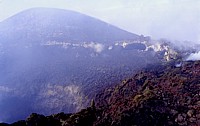 |
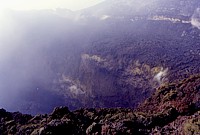
|
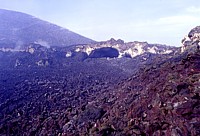 |
The
mysterious heart of the Northeast Crater: a tremendous pit
with vertical, in places even overhanging walls, which most
of the time is filled with dense gas and the roaring sound
of degassing at its floor. This pit produced a brief (about
90 minutes) but extremely violent episode of lava fountaining
on 27-28 March 1998, ten days before these photographs were
taken. The pyroclastic deposit of that episode is well recognizeable
for its dark color, and the coating on the rims of the pit
is evident as well as some structures indicating backflow
into the pit of the still-fluid deposit around it. The most
remarkable feature is a wide cave, whose entrance lies in
an arcuate subsidence fault, and which was not there before
the late March eruptive episode. I did not dare to get into
the cave due to the apparent instability of the whole terrain;
however, some other people did at the time. Three-and-a-half
months later, the Northeast Crater was buried under several
meters of pyroclastics ejected from the nearby Voragine
during a much more powerful paroxysm than the late March
event, and all features except for the central pit and the
high northern rim of the crater (visible in the background
of the left photograph) vanished forever |
|
![]()





































